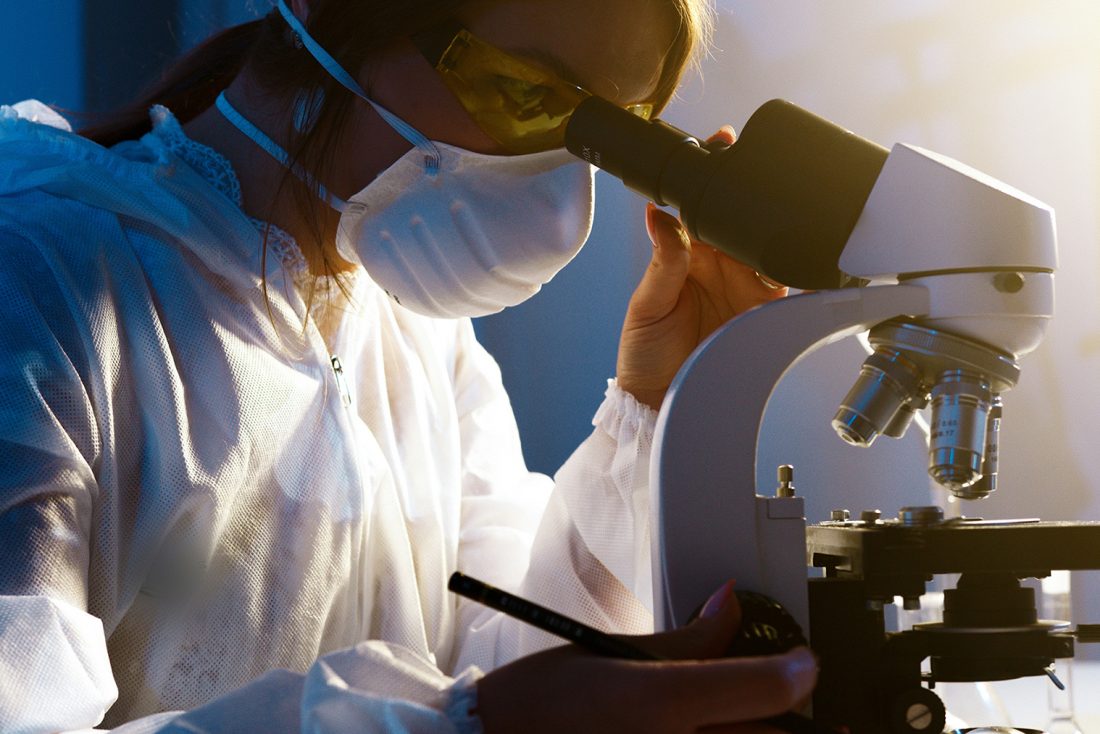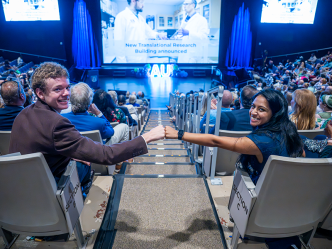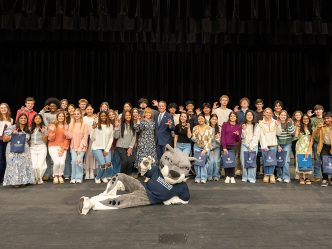Kari Martin was walking around the Vascular Biology Center at the Medical College of Georgia one day and noticed most of the people she passed were women.
Martin, who is the vascular biology graduate program coordinator, said the center has always had women in science and research but she was excited to see how the numbers have grown over the years.
VBC celebrated 25 years last year. It was founded by Dr. John Catravas in 1995 with the vision of creating a critical mass of accomplished researchers who were focused on a single disease area and one particularly important to Georgia: cardiovascular disease.
Dr. Ruth Caldwell was one of the founding members of the VBC research team. She said the goal was to create a multidisciplinary research group with a focus on vascular biology. Her initial role was research focused on various aspects of retinal vascular biology, including mechanisms of retinal angiogenesis and blood-retinal barrier function.
“Discovery science has been a longtime interest for me,” said Caldwell, who has been doing research since entering graduate school in the mid-1970s. “I became interested initially during an advanced chemistry course in my senior year of high school, but I later realized that biomedical research was more appealing.”
A career researcher

Caldwell graduated with a Bachelor of Arts with a major in math from Agnes Scott College in Decatur, Georgia, a Master of Science and PhD in Biopsychology/Neuroscience from the University of Memphis in Tennessee, as well as receiving post-doctoral training in vision neuroscience at the University of Tennessee Center for Health Sciences.
Her roles have changed during her time at Augusta University, from tenured professor to rehired professor emerita, while continuously directing her NIH R01-funded research grants and training graduate students and post-doc fellows in retinal vascular biology research. She also has a 5/8 VA appointment supported by VA Merit Review and VA Research Career Scientist awards.
Caldwell, who is currently researching mechanisms of retinal neurovascular disease and injury in blinding eye diseases, said she was encouraged by a mentor.
“A great opportunity was provided by my post-doctoral mentor, who guided me in developing my first R01 grant when I was a new Instructor at the University of Tennessee Center for Health Sciences,” she said. “After that, I have been inspired by interactions with other leaders in my field who I have gotten to know at scientific meetings and while serving on various review committees for the NIH, Juvenile Diabetes Foundation, Fight for Sight and AHA.”
Finding a passion

Doctoral student Candee Barris is finishing her second year in the program, studying biomedical sciences with a focus in vascular biology. She said she’s always been fascinated by the human body.
“The average teenager finds a hero in athletes, music icons and famous celebrities, but in high school, when I was asked to write a paper nominating an uncommon hero, I chose the selfless people who will give their bodies to the pursuit of science: cadaveric donors,” Barris said.
“Even as an adolescent, I believed that biological sciences were both beautiful and complex, from the researchers who discover new ways to alleviate the negative impacts of diseases, to those who give the precious gift of their bodies to advance scientific techniques and discoveries. From an early age, I knew that my enthusiasm for understanding the workings of the human body could be partnered with scientific research and would be an influencing and driving force in my life.
“I was, as I still am now, excited to continue along this challenging, yet rewarding, journey to advancing scientific knowledge and improving human health.”
Barris has a desire to stay in academia. She also noted that as an independent scientist, research will provide her with a dynamic base from which “I can mentor and teach future scientists, advance scientific knowledge and improve human health.”
Currently, her research focus is on discerning the contribution and absence of female sex hormones. She said historically, women have been underrepresented in the STEM fields, both as scientists as well as subjects of study.
“Having been previously classified as a protected/vulnerable population, women were excluded from clinical trials … the impact of this decision resulted in many drugs on the market having been only tested in men,” she said. “Ultimately, this was a disservice to women as the female body has physical anatomical and hormonal characteristics differentiating them from their male counterpart. My goal is to help rectify the research gaps from years past.
“A major focus of the laboratory of my mentor, Dr. Eric Belin de Chantemele, has been to understand the sex-specific mechanisms for the development of cardiovascular diseases. My current research aims to determine the mechanism by which postmenopausal women develop obesity-associated hypertension.”
Barris said she has always been curious, “something I think is a bit of a prerequisite to being a research scientist.” She credits professor Lisa Ruggiero-Wagner, who offered her an opportunity to serve as a student teaching assistant for human anatomy and physiology labs; Dr. Josefa Guerrero-Millan, who accepted her as an undergraduate research student in her lab; Dr. Colleen Davis, who encouraged her to apply to the biomedical sciences PhD program; and her current mentor, Belin de Chantemele, whose “exceptional guidance and knowledge has augmented my aspirations of continued research.”
“A curious nature can either get you into trouble or annoy those around you. The trick is to find those along the way who encourage your inquisitiveness and foster an environment to fulfill the desire to know more,” Barris said.
Dedicated to the field

Dr. Jie Li is currently a tenure track assistant professor who focuses most of her efforts on research, teaching and service. Her primary research interest is to understand how to prevent and treat heart failure, a disease that is the leading cause of morbidity and mortality worldwide.
“I am dedicated to fostering the next generation of scientists in the classroom and laboratory setting, and also involved in teaching graduate and medical students a number of different courses,” said Li, who also participates in interviewing and recruiting medical students for MCG while serving as a reviewer for national and international funding agencies and scientific journals.
For Li, her interest in research continues to be ever-increasing. She said growing up, she was often inquisitive about many concepts.
“I was a curious child, using worms and such as my everyday toys. Later on in my graduate training, I found myself fond of performing delicate experiments and enjoyed the excitement of tackling challenging questions. The more I explore in this world of science, the more my fascination broadens,” she said.
Li is currently the principal investigator on an NIH R01 project that is focused on how a small protein modifier called UFM1 can regulate the function of heart muscle cells. Li said their published and unpublished findings have uncovered a previously unappreciated role of UFM1 in defending against stress-induced damage to the heart.
“The ultimate goal of our research in this line is to develop novel measures to manipulate this pathway to provide protection against heart failure and other cardiac disease,” said Li, who is also a co-investigator on one NIH and one AHA Transformational Project Award grant with collaborator, Dr. Huabo Su, an associate professor in VBC. These two studies are to investigate how heart muscle cells monitor the fitness of their power house, a subcellular organelle that generates energy essential for rhythmic heart beating.
Along her journey, Li said there are so many people she wants to thank, including her PhD/postdoc mentor Dr. Xuejun Wang, who is a professor at the University of South Dakota, “for being a role model and for guiding me on the right path.”
“My collaborator Dr. Honglin Li, who is a spearhead in the ufmylation study and has been very generous by sharing his mouse lines and reagents with me, as well as his perspective on how we can drive our research deeper and further,” Li said. “I was fortunate to be fostered in a great research environment, the VBC, where I received tremendous mentoring from the faculty there, particularly Drs. Neal L. Weintraub and David Fulton, who have been continuously providing critical feedback on research design, execution and grantsmanship.
“Last but not least, my life could not have been as it is without the unconditional support from my family, my beloved husband and my three kids,” Li added. “They are the ones who cheer me up when I come across a complication in my research every once in a while. They are always making fun of me, saying, ‘How is your uf-my-lation going? Did I pronounce it right this time?’”
Women in research
Currently, 43 women are either core faculty, research faculty, graduate students, postdoctoral fellows or lab technicians in the VBC.
While March is Women’s History Month, Barris said she has a responsibility to continue to promote and encourage science and research all year long.
“It is incumbent upon all scientists to advance scientific knowledge through continued deliberate, innovative research and to encourage the creative minds of the brilliant and influential scientists who will one day replace us,” Barris said. “This is especially true for women scientists by actively encouraging female students to consider scientific research. Many celebrated women scientists have helped pave the way, but it is the responsibility of all scientists to continue this legacy by advocating and promoting the desire for research.”
Caldwell’s advice to young girls who might be interested in getting into science and research is simple.
“Just try it … research is fun, and I’m sure you’ll like it.”
Caldwell also relishes the opportunity to be a positive example in the science field while also fostering a positive environment to explore one’s curiosity for science and research.
“A major focus throughout my career has been on encouraging and facilitating the career development of young investigators — both male and female — to become independent investigators,” Caldwell said.
Li said being a woman scientist with three children, getting to this point was not easy. She is constantly finding ways to have the best balance between her research and her family. The bottom line, Li expresses, is never stop chasing your dream.
“I have always worked with female scientists in the past and have female trainees and staff in my own lab … I always encourage them not to stop chasing their own career goals simply because we are women,” Li said. “I am open and always available to them, and I never hesitate to share my feelings and experiences in handling stress from family and research. I truly believe that women can make as much contribution to research as men do, if not more.”
 Augusta University
Augusta University




